Mon 4 Apr 2022
A PI Movie Review by David Vineyard: A LOVELY WAY TO DIE (1968)
Posted by Steve under Mystery movies , Reviews[5] Comments
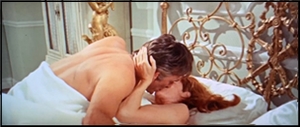
A LOVELY WAY TO DIE. Universal Pictures, 1968. Kirk Douglas, Sylvia Koscina, Eli Wallach, Kenneth Haigh, Sharon Farrell, Ralph Waite. Screenplay by A. J. Russell. Directed by David Lowell Rich. Currently available on YouTube.
I confess I like this slightly smarmy, somewhat generic private eye tale more than it has any right to be liked.
I hadn’t seen it since the mid-eighties, and then on television with commercials, so it was a pleasant surprise to find it on YouTube and discover it was pretty much the film I remembered, with all the caveats above including a few new ones about how quickly it veers from near comedy to melodrama like a leaf in the wind.
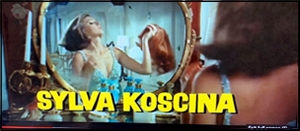
Kirk Douglas is Jameson “Skye†Schuyler, a New York City cop who as the film opens resigns from the force after busting one too many heads. Schuyler is that staple of the movies, the tough cop whose methods are too direct for his own good.
He’s no Dirty Harry or Popeye Doyle. He’s about as generic tough guy cop fed up with bureaucracy as you can imagine. That’s okay because it only takes up about three minutes of plot time anyway.
He’s also a womanizer and a bit of a rat as the opening scene demonstrates, but this isn’t film noir by any stretch. His playboy lifestyle is played strictly for comedy up to the point he spots some made men in a bar and busts heads.
To be honest I don’t think anyone involved with this other than Douglas or Wallach would know film noir if it bit them.
No sooner is Douglas out of a job than he gets a call from Tennessee Fredericks (Eli Wallach), a smooth talking Southern Fried criminal defense lawyer who never lost a case and isn’t planning on doing so with his latest client, Rena Westabrook (Sylvia Koscina), whose husband took a bullet in their pool after they argued while she was out on the town with playboy Jonathan Fleming (Kenneth Haigh).
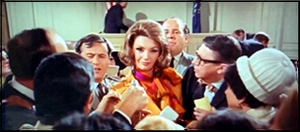
Now Rena and Fleming are about to go on trial for murder and Fredericks wants Schuyler to baby sit her on her estate, keep Fleming away, and do a little private investigating into anything Fredericks can use, including the only witness he has, local tree trimmer Sean Maguire (Ralph Waite) who saw the couple outside a local bar when the murder happened.
It’s pleasant work, pleasant wages, and pleasant scenery in the person of Rena and her maid (Sharon Farrell) who liked to wear her clothes and flirt with her husband. Farrell has nothing to do, but she fills out a maid’s uniform nicely.
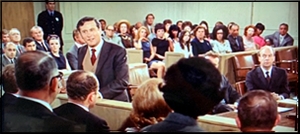
Rena is a bit of a kook, honest to a fault that she married her husband for his money and didn’t love him or even like him. Her nickname is Gypsy, and it fit her even if her in-laws meant it as an insult. She wears it as a badge of honor.
And Fredericks is too slick by half: “Would you trust someone who hadn’t been south of Mason-Dixon since he was eight and talks with that accent?†Schuyler asks him.
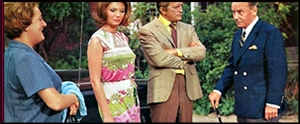
Things start going wrong almost as soon as Schuyler moves in. It’s hard to keep Fleming away and Rena doesn’t cooperate much. Then Maguire disappears, their only collaborating witness, and there is something going on at the neighboring mansion of a reclusive Englishman that has men with guns hanging around and a body in a freezer.
Still, even with all that going on Schuyler and Rena start to flirt and play at the edges of things.
Rena: You’re really a terrible man, did you know that?
Schuyler: You’ve got some admirable qualities yourself.
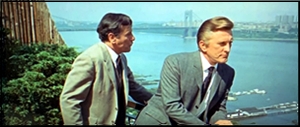
You know they are going to end up horizontal, and true to the somewhat bi polar nature of the film there is a funny morning after scene when Schuyler does the walk of shame back to his room barefoot past the staff.
As the trial goes on there is an attempt to kill Schuyler, then a body shows up and the police want to question him, but slowly he starts to put the pieces together, and finds a tie other than Rena and Fleming between her husband and the tree trimmer. Meanwhile Rena is lying about Fleming and sneaking out to see him. Did she murder her husband after all?
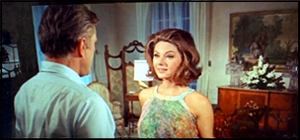
The film is pretty to look at. New York seldom looked prettier outside of one of those glamorous Doris Day pictures from a decade before, though the sets are pretty generic. Douglas seems to be having fun in a much lighter mode than usual, and Koscina in a series of bikinis, sleek outfits, and negligees is more than worth looking at in widescreen technicolor as well as good on screen.
She seldom got to act in American films, but she was certainly worth watching.
Basically this is the film equivalent of a Frank Kane Johnny Liddell book or a lesser Peter Chambers novel by Henry Kane. There’s nothing special, but the mystery isn’t bad, there’s some action, only one really big slap up the head moment I won’t give away, pretty girls in various states of undress, and big name stars like Douglas and Wallach having fun without phoning it in.

In the years since I first saw this in the theater it still holds up for me. I will not be shocked if it doesn’t for you. It’s not any kind of a classic, not special in any way, not overly witty, or exceptionally well directed or photographed (some of it looks like it was made for television as too many films of that era do).
I just happen to like it, smarmy as it may be. It does its job for its running time, doesn’t embarrass itself, and says goodnight politely without leaving a bad taste, but I admit freely I might not like it half as well if I had first seen it at thirty and not eighteen.
You might want to keep that last thought in mind if you seek it out.
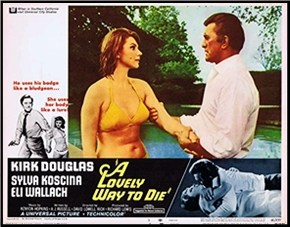
April 4th, 2022 at 9:55 pm
Universal had the B+-movie down to a well-mixed formula by the time they made this: a leading man (George Peppard, Richard Johnson, young Clint Eastwood….) a character actor (Lee J Cobb, Raymond Burr, Nigel Green…)and a sexy leading lady (Gayle Hunnicutt, Elke Sommer, Ms Koscina…)mixed with leering sex and plenty of action.
I always enjoyed it!
April 4th, 2022 at 10:18 pm
Dan, that fits this to a tee. In fact watching this I thought of PJ, though that’s much harder boiled and more serious than this one.
Perhaps the most interesting thing about is that bi polar business between serious mystery and rom com with Douglas almost playing two distinct roles as the tough as nails ex cop turned private eye and bemused by and attracted to the seductive Koscina.
April 5th, 2022 at 12:09 am
Regarding PJ, I have seen it several times in an effort to figure out what went wrong for me. The cast was certainly there, and probably the story and script, but the production seemed hamfisted. And of that cast, John Qualen in his scene with Peppard was marvelous. Coleen gray had too little screen time, but I found her more appealing than Gayle. Oh, well.
April 5th, 2022 at 9:41 am
[…] Vineyard’s latest review at Mystery*File is of A Lovely Way to Die (1968), a private eye film directed by David Lowell Rich (Madame X) and […]
April 5th, 2022 at 9:09 pm
PJ is another film that if I had seen first older I might feel the same as you. As it was I saw it on the big screen and it worked enough. Peppard did several films in that period that I like better than many reviewers including HOUSE OF CARDS,THE EXECUTIONER, THE THIRD DAY, TOBRUK, and ROUGH NIGHT IN JERICHO.
Maybe I was just a Peppard fan and didn’t realize it.
I was a little more jaundiced toward PJ on a recent viewing, but still came down on the right side of happy with it, but I can see clearly where someone else might not.